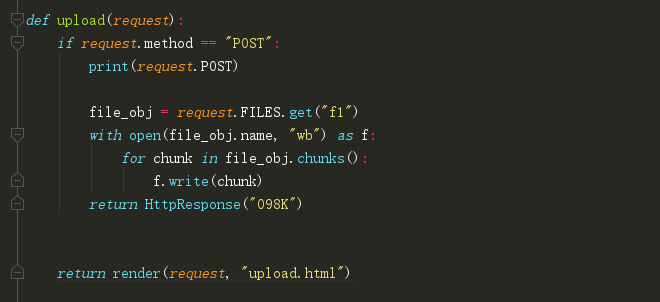一、Ajax简介
#1、Ajax是什么 异步Javascript和XML,即使用Javascript语言与服务器进行异步交互,传输的数据为XML(当然,传输的数据不只是XML,现在更多使用json数据)。
django使用时别忘了在static中放一个jquery #同步交互:客户端发出一个请求后,需要等待服务器响应结束后,才能发出第二个请求; #异步交互:客户端发出一个请求后,无需等待服务器响应结束,就可以发出第二个请求 #2、Ajax的特点 #异步 #页面的局部刷新 #3、AJAX常见应用情景 整个过程中页面没有刷新,只是刷新页面中的局部位置而已! 当请求发出后,浏览器还可以进行其他操作,无需等待服务器的响应!
最基本的用法

#使用get请求往后台提交数据 <head> <meta charset="UTF-8"> <script src="/static/jquery-3.3.1.js"></script> #需要jquery <title>Title</title> </head> <body> <button class="btn">点击</button> #绑定时间 </body> <script> $('.btn').click(function(){ $.ajax({ url:'index/?name=pdun', type:'get' #多了一种往后台提交数据的方式,再路由后拼问号 }) }) </script> </html> ---------------------------------------- #视图函数 from django.shortcuts import render,HttpResponse # Create your views here. def index(request): if request.method=='GET': print(request.body) print(request.GET) print(request.POST) return render(request,'index.html') else: print(request.body) print(request.GET) print(request.POST) return HttpResponse('ok') ----------------------------- #点击一次后端打印一次结果 <QueryDict: {'name': ['pdun']}> <QueryDict: {}>
加深ajax异步理解

#ajax任务提交后,不等结果,继续执行下面的代码, #下面的代码就是,先alert(123),等post请求sleep3秒后,alert(ok) <body> <button class="btn">点击</button> #点击按钮 </body> <script> $('.btn').click(function(){ {#alert(1)#} $.ajax({ url:'/index/', type:'post', data:{'name':'pdun','age':1}, success:function (res) { alert(res) #res是后端return的数据 } }) }) alert(123) #先弹出123,点击3秒后弹出后台return的ok </script> from django.shortcuts import render,HttpResponse import time # Create your views here. def index(request): if request.method=='GET': print(request.body) print(request.GET) print(request.POST) return render(request,'index.html') else: time.sleep(3) print(request.body) #b'name=pdun&age=1' print(request.GET) #<QueryDict: {}> print(request.POST) #<QueryDict: {'name': ['pdun'], 'age': ['1']}> return HttpResponse('ok')

#设置一个alert弹框,点击提交按钮,弹出alert框,5秒后再弹出alert框 <!DOCTYPE html> <html lang="en"> <head> <meta charset="UTF-8"> <script src="/static/jquery-3.3.1.js"></script> <title>Title</title> </head> <body> <button class="btn">点我超后台发数据</button> </body> <script> $(".btn").click(function () { $.ajax({ url:'/index/', type:'post', data:{"name":"pdun","age":1}, success:function (data) { alert(data) } }) alert('123') #直接弹出, }) </script> </html> ------------------------------------------------- def index(request): if request.method == 'GET': print(request.body) print(request.GET) print(request.POST) return render(request,'index.html') else: import time time.sleep(5) print(request.body) print(request.GET) print(request.POST) return HttpResponse('ok')
最基本的jQuery发送AJAX请求示例:

<!DOCTYPE html> <html lang="en"> <head> <meta charset="UTF-8"> <title>Title</title> <meta name="viewport" content="width=device-width, initial-scale=1"> <style> .hide { display: none; } </style> </head> <body> <p><input type="text" class="user"><span class="hide" style="color: red">用户名已存在</span></p> <script src="/static/jquery-3.3.1.min.js"></script> {#下面这一项是基于jQuery的基础上自动给我们的每一个ajax绑定一个请求头信息,类似于form表单提交post数据必须要有的csrf_token一样#} {#否则我的Django中间件里面的校验csrf_token那一项会认为你这个请求不是合法的,阻止你的请求#} <script src="/static/setup_Ajax.js"></script> <script> //给input框绑定一个失去焦点的事件 $('.user').blur(function () { //$.ajax为固定用法,表示启用ajax $.ajax({ //url后面跟的是你这个ajax提交数据的路径,向谁提交,不写就是向当前路径提交 url:'', //type为标定你这个ajax请求的方法 type:'POST', //data后面跟的就是你提交给后端的数据 data:{'username':$(this).val()}, //success为回调函数,参数data即后端给你返回的数据 success:function (data) { ret=JSON.parse(data); if (ret['flag']){ $('p>span').removeClass('hide'); } } }) }); </script> </body> </html>
二、文件上传
1、了解请求头ContentType

#这应该是最常见的 POST 提交数据的方式了。浏览器的原生 <form> 表单,如果不设置 enctype 属性,那么最终就会以 application/x-www-form-urlencoded 方式提交数据。请求类似于下面这样(无关的请求头在本文中都省略掉了): POST http://www.example.com HTTP/1.1 Content-Type: application/x-www-form-urlencoded;charset=utf-8 user=lqz&age=22

#这又是一个常见的 POST 数据提交的方式。我们使用表单上传文件时,必须让 <form> 表单的 enctype 等于 multipart/form-data。直接来看一个请求示例: POST http://www.example.com HTTP/1.1 Content-Type:multipart/form-data; boundary=----WebKitFormBoundaryrGKCBY7qhFd3TrwA ------WebKitFormBoundaryrGKCBY7qhFd3TrwA Content-Disposition: form-data; name="user" yuan ------WebKitFormBoundaryrGKCBY7qhFd3TrwA Content-Disposition: form-data; name="file"; filename="chrome.png" Content-Type: image/png PNG ... content of chrome.png ... ------WebKitFormBoundaryrGKCBY7qhFd3TrwA-- 这个例子稍微复杂点。首先生成了一个 boundary 用于分割不同的字段,为了避免与正文内容重复,boundary 很长很复杂。然后 Content-Type 里指明了数据是以 multipart/form-data 来编码,本次请求的 boundary 是什么内容。消息主体里按照字段个数又分为多个结构类似的部分,每部分都是以 --boundary 开始,紧接着是内容描述信息,然后是回车,最后是字段具体内容(文本或二进制)。如果传输的是文件,还要包含文件名和文件类型信息。消息主体最后以 --boundary-- 标示结束。关于 multipart/form-data 的详细定义,请前往 rfc1867 查看。 这种方式一般用来上传文件,各大服务端语言对它也有着良好的支持。 上面提到的这两种 POST 数据的方式,都是浏览器原生支持的,而且现阶段标准中原生 <form> 表单也只支持这两种方式(通过 <form> 元素的 enctype 属性指定,默认为 application/x-www-form-urlencoded。其实 enctype 还支持 text/plain,不过用得非常少)。 随着越来越多的 Web 站点,尤其是 WebApp,全部使用 Ajax 进行数据交互之后,我们完全可以定义新的数据提交方式,给开发带来更多便利。

application/json 这个 Content-Type 作为响应头大家肯定不陌生。实际上,现在越来越多的人把它作为请求头,用来告诉服务端消息主体是序列化后的 JSON 字符串。由于 JSON 规范的流行,除了低版本 IE 之外的各大浏览器都原生支持 JSON.stringify,服务端语言也都有处理 JSON 的函数,使用 JSON 不会遇上什么麻烦。
JSON 格式支持比键值对复杂得多的结构化数据,这一点也很有用。记得我几年前做一个项目时,需要提交的数据层次非常深,我就是把数据 JSON 序列化之后来提交的。不过当时我是把 JSON 字符串作为 val,仍然放在键值对里,以 x-www-form-urlencoded 方式提交。
2、基于Form表单上传数据
<form action="/file_put/" method="post" enctype="multipart/form-data"> 用户名:<input type="text" name="name"> 头像:<input type="file" name="avatar" id="avatar1"> <input type="submit" value="提交"> </form> #必须指定编码 enctype="multipart/form-data"
def file_put(request): if request.method=='GET': return render(request,'file_put.html') else: # print(request.POST) # print(request.POST) print(request.body) # 原始的请求体数据 print(request.GET) # GET请求数据 print(request.POST) # POST请求数据 print(request.FILES) # 上传的文件数据 # print(request.body.decode('utf-8')) print(request.body.decode('utf-8')) print(request.FILES) file_obj=request.FILES.get('avatar') print(type(file_obj)) with open(file_obj.name,'wb') as f: for line in file_obj: f.write(line) return HttpResponse('ok')
3、 基于ajax上传文件
<button id="btn">ajax提交文件</button> </body> <script> $("#btn").click(function () {
//上传文件,必须用FormData var formdata=new FormData(); formdata.append('name',$("#name").val());
//取出文件$("#myfile")[0].files拿到的是文件列表,取第0个把具体的文件取出来 formdata.append('myfile',$("#myfile")[0].files[0]); $.ajax({ url:'/files_ajax/', type:'post',
//不预处理数据,(默认是这种name=lqz&age=18) processData:false,
//指定往后台传数据的编码格式(urlencoded,formdata,json) //现在用formdata对象处理了,就不需要指定编码格式了,不要给我编码了 contentType:false, data:formdata, success:function (data) { alert(data) } }) }) </script>
三、Ajax提交json格式数据
结合上边ContentType,Ajax只支持前两种编码方式,第三种json格式需要手动解码
#这个过程无非就是 #前端获取页面上输入的信息,例如是个对象(字典),把它转成字符串, #后端接收到字符串,转成对应的格式 #把后端处理的数据结果(例如字典类型)转换成字符串,传给前端,前端再转换成对用格式的数据类型

<!DOCTYPE html>
<html lang="en">
<head>
<meta charset="UTF-8">
<script src="/static/jquery-3.3.1.js"></script>
<title>Title</title>
</head>
<body>
<form >
<p>用户名:<input type="text" name="name" id="name"></p>
<p>密码:<input type="password" name="pwd" id="pwd"></p>
</form>
<button id="btn">ajax提交json格式</button>
</body>
<script>
$('#btn').click(function () {
var post_data={'name':$("#name").val(),'pwd':$("#pwd").val()};
console.log(typeof post_data);
// 如何把post_data这个字典,转成json格式字符串
//JSON.stringify相当于python中json.dumpus(post_data)
//pos是个字符串,json格式字符串
var pos=JSON.stringify(post_data);
console.log(typeof pos);
$.ajax({
url:'/json/',
type:'post',
data:pos,
contentType:'application/json',
dataType:'json',
success:function (data) {
//如果data是json格式字符串,如何转成对象(字典)?
//data=JSON.parse(data)
console.log(typeof data) //注意这里不是type
console.log(data.status)
/*
console.log(data)
var ret=JSON.parse(data)
console.log(typeof ret)
console.log(ret.status)
*/
//alert(data)
}
})
})
</script>
</html>

def js(request): if request.method=='GET': return render(request,'file.html') print(request.POST,'这是POST') print(request.GET,'这是GET') print(request.body,'这是body') #把前台传的字符串转换成其它格式 import json res = request.body.decode('utf-8') print(type(res)) #<class 'str'> res1 = json.loads(res) print(type(res1)) #<class 'dict'> #把这个对字典装换成字符串传给前端 dic = {'status':'100','msg':'登陆成功'} # 第一种方式 return HttpResponse(json.dumps(dic)) #第二种方式 # return JsonResponse(dic)
AJAX请求如何设置csrf_token
不论是ajax还是谁,只要是向我Django提交post请求的数据,都必须校验csrf_token来防伪跨站请求,那么如何在我的ajax中弄这个csrf_token呢,我又不像form表单那样可以在表单内部通过一句{% csrf_token %}就搞定了......
方式1
通过获取隐藏的input标签中的csrfmiddlewaretoken值,放置在data中发送。
$.ajax({
url: "/cookie_ajax/",
type: "POST",
data: {
"username": "Tonny",
"password": 123456,
"csrfmiddlewaretoken": $("[name = 'csrfmiddlewaretoken']").val() // 使用JQuery取出csrfmiddlewaretoken的值,拼接到data中
},
success: function (data) {
console.log(data);
}
})
方式2
通过获取返回的cookie中的字符串 放置在请求头中发送。
注意:需要引入一个jquery.cookie.js插件。
 View Code
View Code方式3
或者用自己写一个getCookie方法:
 View Code
View Code每一次都这么写太麻烦了,可以使用$.ajaxSetup()方法为ajax请求统一设置。
function csrfSafeMethod(method) {
// these HTTP methods do not require CSRF protection
return (/^(GET|HEAD|OPTIONS|TRACE)$/.test(method));
}
$.ajaxSetup({
beforeSend: function (xhr, settings) {
if (!csrfSafeMethod(settings.type) && !this.crossDomain) {
xhr.setRequestHeader("X-CSRFToken", csrftoken);
}
}
});
将下面的文件配置到你的Django项目的静态文件中,在html页面上通过导入该文件即可自动帮我们解决ajax提交post数据时校验csrf_token的问题,(导入该配置文件之前,需要先导入jQuery,因为这个配置文件内的内容是基于jQuery来实现的)


如下:

